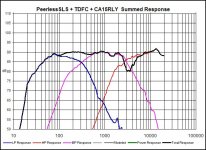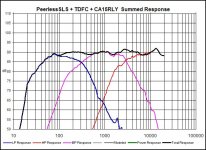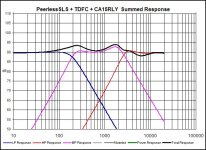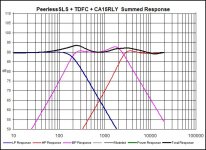Hi, to all!
Well it does look to be a case of 'back to the drawing board'!.
After careful deliberation, my 'simplistic design' might just be that, too simplistic, because other issues may not have been duly considered. So now, it seems a 'full 2nd order electrical' IS required, and I'm happy to follow Omni's specifications on that. (I realize the *acoustic* response is what matters ).
My previous 'higher-order' schematic is maybe the best one to pursue at this stage?. May I also say that I have a very strong belief in 'proven theory' (its my upbringing, my values, lol) but this 'belief' was (how to express it?) unfortunately slightly dissolved by reading ineffectual and inappropriate 'textbook theory'. So maybe I'm finally back 'on track'! I hope so.
I think, my dilemma is still/will always be?, trying to separate 'snake-oil' from the things that really matter. I have an open mind, and assuming SW calculations are correct, (which I'm sure they are), this gives me a wonderful medium to check things by.
I'm not trying to offend anyone here, (quite the opposite!) just offering my thoughts, FWIW. grant
Well it does look to be a case of 'back to the drawing board'!.
After careful deliberation, my 'simplistic design' might just be that, too simplistic, because other issues may not have been duly considered. So now, it seems a 'full 2nd order electrical' IS required, and I'm happy to follow Omni's specifications on that. (I realize the *acoustic* response is what matters ).
My previous 'higher-order' schematic is maybe the best one to pursue at this stage?. May I also say that I have a very strong belief in 'proven theory' (its my upbringing, my values, lol) but this 'belief' was (how to express it?) unfortunately slightly dissolved by reading ineffectual and inappropriate 'textbook theory'. So maybe I'm finally back 'on track'! I hope so.
I think, my dilemma is still/will always be?, trying to separate 'snake-oil' from the things that really matter. I have an open mind, and assuming SW calculations are correct, (which I'm sure they are), this gives me a wonderful medium to check things by.
I'm not trying to offend anyone here, (quite the opposite!) just offering my thoughts, FWIW. grant
As said before, at some point you will have to build and listen to determine if theory and simulation works in practice 🙂
Hi,
2nd order electrical parallel c/o's generally will not need zobels.
For first order electrical c/o's the series topology helps to avoid
zobels, and generally works better in terms of interactions with
driver impedance rises due to inductance or fundamental resonances.
There nothing inherently wrong with electrical 1st order crossovers
if you pay attention to excursion of the the tweeter and mid units,
(WinISDPro).
Not many people realise the higher the resonant frequency of the
driver in some ways the easier a 1st order electrical filter can be.
(model excursion of a tweeter with 1st order and various Fs)
For series 1st order 3-way.
L-pad the tweeter.
http://sound.westhost.com/parallel-series.htm
c/o mid and treble using series first order as detailed above.
Treating the above as a single unit c/o this with the bass series first order.
Note you can mix series and parallel sections, e.g. a series 2-way
with an added 0.5 way parallel section to make a 2.5 way.
🙂/sreten.
2nd order electrical parallel c/o's generally will not need zobels.
For first order electrical c/o's the series topology helps to avoid
zobels, and generally works better in terms of interactions with
driver impedance rises due to inductance or fundamental resonances.
There nothing inherently wrong with electrical 1st order crossovers
if you pay attention to excursion of the the tweeter and mid units,
(WinISDPro).
Not many people realise the higher the resonant frequency of the
driver in some ways the easier a 1st order electrical filter can be.
(model excursion of a tweeter with 1st order and various Fs)
For series 1st order 3-way.
L-pad the tweeter.
http://sound.westhost.com/parallel-series.htm
c/o mid and treble using series first order as detailed above.
Treating the above as a single unit c/o this with the bass series first order.
Note you can mix series and parallel sections, e.g. a series 2-way
with an added 0.5 way parallel section to make a 2.5 way.
🙂/sreten.
Here's a few more response graphs to check out...........Any analysis would be greatly appreciated, but I think they still need a bit more work? I have not been able to draw the schematic correctly in SW so here ore the component values: Woofer:8.6 mH series inductor, and 90uF shunt cap, classic 12dB set up...Midbass: 90uF series cap, and 4.59 shunt inductor.............. .37mH series inductor, 11uF shunt cap.......Tweeter....7.5 series cap, .31 shunt inductor..........Zobel in tweeter 2 uF...9 ohm............Midbass polarity reversed
Attachments
This graph has the tweeter polarity reversed in addition to the reversed midbass polarity....Woofer is normal polarity.........Like I mentioned before, still more "tightening up" required.......But any observations, analysis, and guidance will be greatly appreciated..........I have been working obsessively on this and think things are starting to shape up slowly..............Grant I have been playing around with multitudes of combinations and component values and I sincerely believe that, though it is in it's infant stages..............This is a testimony to your work thus far..........Respectfully............Omni.................The Midbass and Tweeter FRD and ZMA files are new trace files processed through thr FRC Tools............I think they are more accurate than the original files we started with.
Attachments
Omni,
Are you saying that you have finished re-processing your files already? So soon? Are these the final versions in such speedy time! IF processing is now complete, may I have a copy of the (6, lol) new files please? Because I would like to sim it myself with your values, then experiment and compare results. Btw, what are the coils DCR's please.
Of these latest graphs, the second one looks pretty good so far! I tried inverting both mid and tweeter just now in my first 'higher order' circuit for your drivers, and got something ugly looking. I think you're well on your way to taming the beast! <grin> Soon it will be 'alive'! grant
Are you saying that you have finished re-processing your files already? So soon? Are these the final versions in such speedy time! IF processing is now complete, may I have a copy of the (6, lol) new files please? Because I would like to sim it myself with your values, then experiment and compare results. Btw, what are the coils DCR's please.
Of these latest graphs, the second one looks pretty good so far! I tried inverting both mid and tweeter just now in my first 'higher order' circuit for your drivers, and got something ugly looking. I think you're well on your way to taming the beast! <grin> Soon it will be 'alive'! grant
Omni,
This is a good thread --->
www.diyaudio.com/forums/showthread.php?s=&threadid=91616
all about baffle step.
Btw, thanks for Mr Bagby's info, very good, your questions were spot on ! grant
This is a good thread --->
www.diyaudio.com/forums/showthread.php?s=&threadid=91616
all about baffle step.
Btw, thanks for Mr Bagby's info, very good, your questions were spot on ! grant
Sreten, Hi:
I've been re-reading Rod Elliots series-parallel treatise, and I note his concluding remarks. Series is superior for '1st order' but for 2nd order, there is no clear 'winner' both have pluses and minuses. If a series '1st order' electrical is possible for Omni's mid HP/LP , in combination with parallel 2nd order for woofer and tweeter then it would be worth considering. I would have to do lots of extra study, but thats ok, if I can find additional resources. I assume any resulting network could still be simulated in SW. If you could offer any further guidance re mixed networks , specifically for 3ways, it would be much appreciated. thanks, grant
I've been re-reading Rod Elliots series-parallel treatise, and I note his concluding remarks. Series is superior for '1st order' but for 2nd order, there is no clear 'winner' both have pluses and minuses. If a series '1st order' electrical is possible for Omni's mid HP/LP , in combination with parallel 2nd order for woofer and tweeter then it would be worth considering. I would have to do lots of extra study, but thats ok, if I can find additional resources. I assume any resulting network could still be simulated in SW. If you could offer any further guidance re mixed networks , specifically for 3ways, it would be much appreciated. thanks, grant
Sreten, I forgot to ask some things:
My mid's resonance is possibly 500Hz? not sure (its so old) likewise tweeter maybe 1700Hz? who knows? (I don't have manuf's spec sheets for either!). Just for fun (and limited finances), I would like to try to use them if remotely possible in a cheap and err, 'nasty' 2nd order, before replacing them with Seas 27TD(B?)FC and maybe the Seas CA15 mid. So your comments intrigued me.....
Re: modeling in WinISDPro, your comment, (quote, format edited): "Not many people realise the higher the resonant frequency of the driver in some ways the easier a 1st order electrical filter can be. (model excursion of a tweeter with 1st order and various Fs)"
How can this can be? I haven't modeled them yet in WinISD, but to me it seems contrary to what I *thought* I had understood so far, i.e. less attenuation near resonance = higher distortion. 'Generalising' Zaph on modern tweeters in his 'Tweeter Mishmash' -->, don't xo 'specific tweeters' below 2kHz LR4 (or 2.5kHz LR2) *because of distortion*. I'm wondering how a lower order electrical,
i.e. 1st, then could possibly match with a driver with a higher resonant frequency? Whats happening here? You did however, beforehand qualify your comment with this, (quote):
"There nothing inherently wrong with electrical 1st order crossovers if you pay attention to excursion of the the tweeter and mid units"
But surely distortion would increase (due to increased excursion) IF the Fs was higher and a 1st order was used, at a similar xo point? *I'm just interested, thats all, not trying to be provocative*.
I NEED to undestand this!
Have I interpreted you and Zaph correctly here? Or do you disagree with him on this? Indeed, I think it was 'Rabbitz' (G'day!) in another thread re: 27TDFC who said he had crossed it first order at 2kHz (I think) but qualified the volume to 'being loud but sensible' (or something like that), without a reference to distortion - all from memory, so I could be a bit inaccurate on this. (Please excuse me if I have misquoted you on this Rabbitz!).
Sreten...If you could please clarify this for me, I would be.......(you know, lol) thanks, grant
(the reason I'm asking this is in relation to the viability for my D25TG&D75MX and also Omni's 27TDFC tweeter) because it could make a difference to his final design ( and mine).
My mid's resonance is possibly 500Hz? not sure (its so old) likewise tweeter maybe 1700Hz? who knows? (I don't have manuf's spec sheets for either!). Just for fun (and limited finances), I would like to try to use them if remotely possible in a cheap and err, 'nasty' 2nd order, before replacing them with Seas 27TD(B?)FC and maybe the Seas CA15 mid. So your comments intrigued me.....
Re: modeling in WinISDPro, your comment, (quote, format edited): "Not many people realise the higher the resonant frequency of the driver in some ways the easier a 1st order electrical filter can be. (model excursion of a tweeter with 1st order and various Fs)"
How can this can be? I haven't modeled them yet in WinISD, but to me it seems contrary to what I *thought* I had understood so far, i.e. less attenuation near resonance = higher distortion. 'Generalising' Zaph on modern tweeters in his 'Tweeter Mishmash' -->, don't xo 'specific tweeters' below 2kHz LR4 (or 2.5kHz LR2) *because of distortion*. I'm wondering how a lower order electrical,
i.e. 1st, then could possibly match with a driver with a higher resonant frequency? Whats happening here? You did however, beforehand qualify your comment with this, (quote):
"There nothing inherently wrong with electrical 1st order crossovers if you pay attention to excursion of the the tweeter and mid units"
But surely distortion would increase (due to increased excursion) IF the Fs was higher and a 1st order was used, at a similar xo point? *I'm just interested, thats all, not trying to be provocative*.
I NEED to undestand this!
Have I interpreted you and Zaph correctly here? Or do you disagree with him on this? Indeed, I think it was 'Rabbitz' (G'day!) in another thread re: 27TDFC who said he had crossed it first order at 2kHz (I think) but qualified the volume to 'being loud but sensible' (or something like that), without a reference to distortion - all from memory, so I could be a bit inaccurate on this. (Please excuse me if I have misquoted you on this Rabbitz!).
Sreten...If you could please clarify this for me, I would be.......(you know, lol) thanks, grant
(the reason I'm asking this is in relation to the viability for my D25TG&D75MX and also Omni's 27TDFC tweeter) because it could make a difference to his final design ( and mine).
Look closely at bass lowend rolloff curve, nice and smooth round rolloff - this is what you want on ALL slopes 😉
Hi Tinitus, welcome back! yes steep and smooth rolloffs ideally would be nice! Difficult to achieve in practice though! grant
Thanks,
No, not steep - if you study bass lowend rolloff it starts lightly and gets steeper all the way down - no straight line, and if I remember correctly its a genuine pure 12db rolloff, which is the nature of closed box - THATS your reference
To achieve that means not only changing component values, but also some fiddling with crossoverpoints, dampening resistors on paralel components etc. - and that might look like a 6db with zobels, but its only electrically - acoustically you might get a real 12db slope
No, not steep - if you study bass lowend rolloff it starts lightly and gets steeper all the way down - no straight line, and if I remember correctly its a genuine pure 12db rolloff, which is the nature of closed box - THATS your reference
To achieve that means not only changing component values, but also some fiddling with crossoverpoints, dampening resistors on paralel components etc. - and that might look like a 6db with zobels, but its only electrically - acoustically you might get a real 12db slope
Tinitus, I'm sorry!
I was not specific enough! I meant steep on everything *except* Omni's woofer rolloff in the low end, say below 200Hz. I should have specified that! Thank you!
Also, I am trying to help Omni with his crossover, he's been working so diligently, but he lives in the USA maybe 10,000 kilometres away from me in Australia. I'm very grateful for your advice, thanks very much , and very best wishes, grant (I hope your violins sound like Stradivarius!).... spelling?
I was not specific enough! I meant steep on everything *except* Omni's woofer rolloff in the low end, say below 200Hz. I should have specified that! Thank you!
Also, I am trying to help Omni with his crossover, he's been working so diligently, but he lives in the USA maybe 10,000 kilometres away from me in Australia. I'm very grateful for your advice, thanks very much , and very best wishes, grant (I hope your violins sound like Stradivarius!).... spelling?
Hi,
(simplified somewhat)
Consider a tweeter with a required crossover that you get the
response you want with a 1st order electrical crossover at 4khz.
Excursion increases 12dB per octave you go down, with 6dB c/o it is
still increasing at 6dB octave so will be 12 dB higher at 1khz than 4khz.
But this is forgetting the Fs of the tweeter. Response below
Fs of the tweeter rolls off at 12dB octave matching the increase.
So the excursion of the tweeter levels at Fs of the tweeter, and
falls 6dB octave below Fs (18dB per octave amplitude response).
Given the first paragraph the higher the Fs of the tweeter, the
more juice can be applied, but also note the higher the Fs the
higher the actual acoustic response becomes 3rd order.
The same arguements apply to a midrange unit, but if its open
backed (this is one reason many are closed) you can adjust Fs.
Putting a low excursion mid in too big a volume with a 1st order
electrical crossover is generally not a good idea. Excursion of
the unit will increase down to ~ Fb and then start decreasing.
🙂/sreten.
(simplified somewhat)
Consider a tweeter with a required crossover that you get the
response you want with a 1st order electrical crossover at 4khz.
Excursion increases 12dB per octave you go down, with 6dB c/o it is
still increasing at 6dB octave so will be 12 dB higher at 1khz than 4khz.
But this is forgetting the Fs of the tweeter. Response below
Fs of the tweeter rolls off at 12dB octave matching the increase.
So the excursion of the tweeter levels at Fs of the tweeter, and
falls 6dB octave below Fs (18dB per octave amplitude response).
Given the first paragraph the higher the Fs of the tweeter, the
more juice can be applied, but also note the higher the Fs the
higher the actual acoustic response becomes 3rd order.
The same arguements apply to a midrange unit, but if its open
backed (this is one reason many are closed) you can adjust Fs.
Putting a low excursion mid in too big a volume with a 1st order
electrical crossover is generally not a good idea. Excursion of
the unit will increase down to ~ Fb and then start decreasing.
🙂/sreten.
- Status
- Not open for further replies.
- Home
- Loudspeakers
- Multi-Way
- 3way XO help greatly appreciated!



